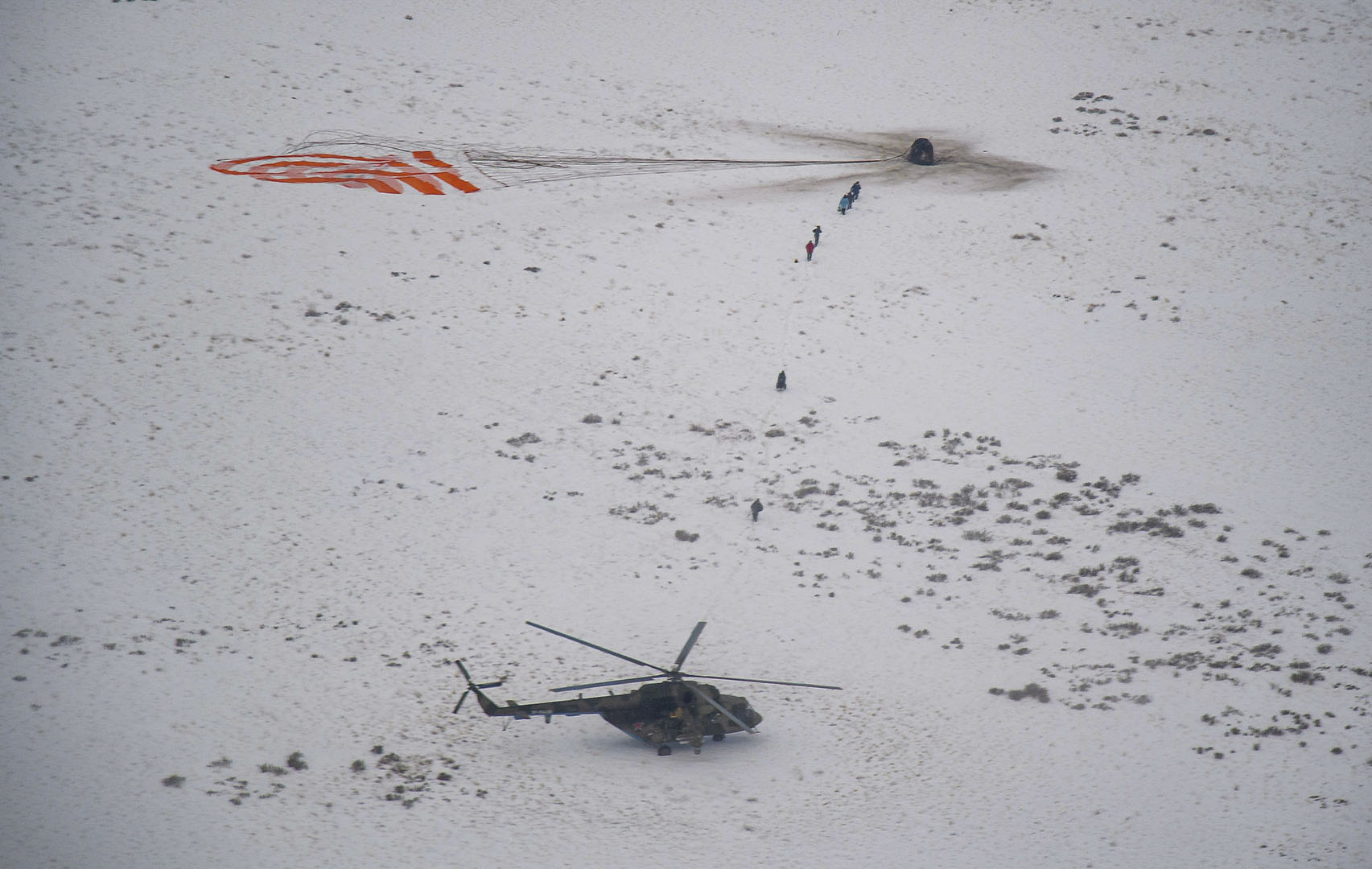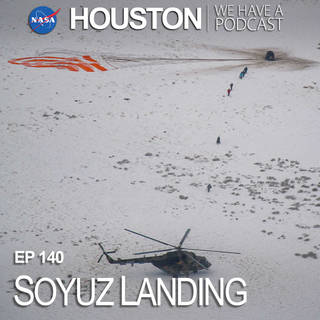
If you’re fascinated by the idea of humans traveling through space and curious about how that all works, you’ve come to the right place.
“Houston We Have a Podcast” is the official podcast of the NASA Johnson Space Center from Houston, Texas, home for NASA’s astronauts and Mission Control Center. Listen to the brightest minds of America’s space agency – astronauts, engineers, scientists and program leaders – discuss exciting topics in engineering, science and technology, sharing their personal stories and expertise on every aspect of human spaceflight. Learn more about how the work being done will help send humans forward to the Moon and on to Mars in the Artemis program.
For Episode 140, hear a behind-the-scenes narrative into the operational intricacies of a 2018 Soyuz landing and the choreography of personnel, vehicles, and more when recovering the astronauts and cosmonauts returning to Earth from the International Space Station. Sounds for this podcast were recorded during the landing trip of December 2018. Interviews were recorded in March of 2020.

Transcript
[Background Music]
Gary Jordan (Host): December 15, 2018. It’s early in the morning on a Saturday. Pretty chilly, but it’s Houston, so it’s manageable. Especially compared to where we’re going. I’m boarding NASA’s Gulfstream G-III aircraft. Onboard is a fairly small group. Bill Ehrenstrom and Chris “Trigger” Condon will alternate as pilot for each of the first two legs. Adam Kline, as co-pilot, and Allison Hickey, keeping them in check. Angel Vasquez is the mechanic. He’ll be joining us for the duration of the trip, making sure the plane is ready to fly at all times. As for the passengers, there is Kenny Todd, Deputy Manager in the Space Station Program. Kate Rubins, Astronaut, among other things. Shannan Moynihan; medical doctor, and myself, Gary Jordan, a Public Affairs Officer who feels very much out of place. We’re taking off from Ellington Field, a small airport southeast of Downtown Houston. It’s mostly a military airport. It has some civilian traffic, but NASA also has a decent presence there. It’s the same airport where astronauts take off in T-38 training jets, to keep up their flight certifications. We’re about to head out to Karaganda, one of the larger cities in the Asian country of Kazakhstan, halfway around the world. From here, we’ll be meeting up with a few dozen other people from many nations to conduct one of them most impressive logistic performances I’ve ever encountered. The recovery of a Soyuz capsule, carrying two astronauts and a cosmonaut, who are coming back from a six-month stay on the International Space Station. This carefully coordinated ensemble will involve an international team, some helicopters, some ATVs, even some SUVs, all rolling out in the middle of the desert in Kazakhstan, called The Steppes. All in sub-zero temperatures, to fetch this space capsule and the crew inside. You’re listening to Houston, We Have a Podcast! This is the official podcast of NASA’s Johnson Space Center. We talk with scientists, engineers, astronauts, all some of the coolest people at NASA, and for the most part, we focus on human spaceflight. Today, we’re bringing you the story of how a Soyuz landing operation works. The Soyuz is the Russian vehicle cosmonauts have been traveling to space in since the ’60s, but for almost two decades, it has carried astronauts and cosmonauts from many nations to and from the International Space Station. When the vehicle returns to Earth, it lands in the middle of the desert in Kazakhstan. The vehicle, and more importantly, the astronauts and cosmonauts inside, are recovered by teams on these helicopters and all-terrain vehicles who know where and when they will be landing, and who have a few back-up plans in place just in case something doesn’t go exactly the way it’s supposed to. To help me tell this story is Kenny Todd, Chad Rowe, Bill Ehrenstrom, and Shannan Moynihan, all who join me on this trip, and go into way more detail on just how everything works. So here is a little bit behind the scenes of a Soyuz landing operation. Enjoy.
[ Music]
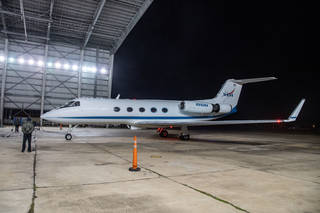
Host: It’s my second time flying to Kazakhstan. First time on the Gulfstream G-III aircraft. It’s an older, private jet converted into a research plane. Pilots and scientists will take this plane out to different parts of the world, like Greenland, or even Hawaii, and can load a variety of instruments onboard. Some that study air, the water, ice, lots of climate studies. This is Bill Ehrenstrom, one of the pilots that flew the G-III.
Bill Ehrenstrom: There was this mission called Oceans Melting Greenland, where we were flying over Greenland, using a radar pod, measuring heights of glaciers. We also had a mission where we dropped sonde buoys out of the back, and measured water temperatures, and salinity, all around Greenland.
[Background music]
Host: It’s very adaptable, and today, it’s being used for what’s called a Direct Return Mission. All of those climate instruments are no longer on the plane. Instead, it’s set up for taking astronauts home, and fast. Two beds, a staff of medical professionals and a plane that can take them to the other side of the planet in a day, right back to the NASA Johnson Space Center, where they’ll get to see their families again. And they’ll get to see NASA scientists and medical professionals who will be studying how they adapt to Earth’s gravity, and make sure they get reconditioned back to “normal life.” But on the way over, they’ll have an extra seat for me, the Public Affairs Officer. On a good day, my job is pretty simple. Report the landing. While everyone else is working to make sure the operation runs smoothly, my job is to let the world know what’s happening. I get a satellite phone, go out to the desert, call into the NASA TV broadcast, and talk about what I’m seeing live, right there on the field. On the bad day, it gets a bit more complicated. But I’m feeling pretty good about this trip, because of who I’m flying with. Kenny Todd has been with NASA for more than 30 years. He’s there as a representative of NASA’s International Space Station Program, and from the NASA side, making sure everything runs smoothly.
[Background music]
Kenny Todd: My role there, really, when you look at the team of professionals that we take over there, we have to have somebody that acts as that liaison to Rosaviatsiya, which is the senior leadership group that runs the search and rescue forces on the Russian side. And so, I see my primary role is helping to make sure that our team is getting what it needs relative to, you know, working with our Russian counterparts.
[Background music]
Host: Kate Rubins is there as a representative of the Astronaut Office. She’s been on the other side of this before, landing from space, riding back in the plane from Kazakhstan, and she has a pretty good idea of what the crew will need when they land. Shannan Moynihan is the Air Doc. It’s her responsibility to take care of the crew’s medical needs on the trip back home. And she is well-prepared to handle that. Everyone else on the plane is there to make sure the plane is ready to fly back. There are pilots already stationed at one of our layover cities.
[Background music]
Bill Ehrenstrom:The Kazakhstan crew is the crew that goes commercial to Europe, then flies the airplane to Kazakhstan, and then stays there. So, we have two crews to do this. So, our biggest problem here is on the way over, so we have a crew duty day limitation of 14 hours. That can be extended to 16 hours, provided none of the flight is between midnight and 4:00 a.m. from the place you left. We can go to 18 hours with three pilots. So those are our crew duty limitations. Well, a typical mission to Kazakhstan takes about 18 hours to get there, going eastbound. It takes about 22 hours generally coming back westbound. So, there is no way to do that with one crew. Just no way. So, we have to have two crews. We have to pre-stage a crew over in Europe in order to do that.
Host: I get sort of nervous packing for trips to Russia. We’re there for so long, and there are so many important items to consider, that I usually give myself about a week to make sure I have everything in order. I’ve been studying the order of things, and some highlights from the three space travelers’ six-month journey that I’ll be able to bring up during my short report. But it takes a lot longer than that to make sure things run smoothly.
[Background music]
Chad Rowe: So, for much of the Space Station Program, especially once the space shuttles were retired, the Soyuz launches, and landings have occurred approximately four times a year.
Host: This is Chad Rowe, NASA’s Human Spaceflight Program Director in Russia, who is the NASA lead for logistics on these trips.
[Background music]
Chad Rowe: And as you can imagine, planning for each of those campaigns begins many months beforehand. So, the earliest stages of planning consist of the finalization of the Space Station flight plan, and this is essentially a flight sequence and schedule, and it includes significant events, including launches and landings of all the vehicles, but also things like extra-vehicular activities and other major events that happen onboard ISS. So that flight planning process is what establishes the formal launch and landing dates, and that ends up being what we go forward with once the Space Station Program manager, Kirk Shireman, and the Russian Space Station Program manager, Alexey Strelnikov come to an agreement on the dates. Those dates can dance around a little bit, so replans are common, but once we know when the rough execution of launches and landings will happen, then we begin our planning sequence in earnest.
[Background music]
Host: This is Bill Ehrenstrom.
Bill Ehrenstrom: These things take a lot of time to plan. We start them out probably four or five months ahead of time, to start the planning. We are what we call a state aircraft, because we’re owned by the United States government. We’re a state aircraft. The normal commercial, or private corporate jet can just go pay some fees and go fly anywhere they want in the world. We can’t do that. We are, because we work for the government, we have to go through our embassies, we have to get what we call overflight clearances, we have to get these, so these things all have to be coordinated well in advance, and four or five months in advance, we’re putting out the requests for overflight clearances.
[Background music]
Host: I show up about 30 minutes earlier than we were told to show up to the G-III, but I’m still one of the last ones there. Everyone has already chosen a seat, they’ve placed their bags in different areas, and laid out some of their essential items. Everyone has a different way of doing things. Some folks deprive themselves of sleep before this trip, so they can take a nap on the first leg. Others prepare movies, books or music. Some folks were nice enough to bring breakfast and coffee, a must for me. My job was to bring chips and salsa. I forgot them last time, but I’m going to make sure everyone gets to have them this time. That’s one of the big social contributions of a public affairs officer on these trips. But it doesn’t come until later in this story. Sure, it used to be a private jet, but for the most part, this G-III has been gutted to make it more practical for NASA’s use. The beds are in the back, in between where we’re all sitting, and the little breakfast and coffee spread. The seats are pretty comfortable, and the bathroom is pretty spacious. And that’s much needed for this 20 hours of travel we’re about to embark on. There’s a lot of chit-chat up front. Everyone is pretty excited to go get our crew. But after a safety message, taxing over and taking off, it doesn’t take much for people to settle in for naps or movies. I’ve brought water and food to keep me going since we really won’t be eating for quite some time. The G-III has enough fuel to get us to Karaganda after two stops. One is in Goose Bay, Canada. And the other is in Bodo, Norway. This is the fastest route, with the most amount of land along the way. If you’ve ever traveled for 20 hours heading east, you’ll know it takes a lot out of you. Especially if your route takes you north in December. You might take off in the day, next thing you know it’s night, then it’s day again, but it feels like night. When we land in Karaganda December 16th, it’s a sigh of relief, but we’re still not done. Thankfully Chad Rowe, NASA’s Human Spaceflight Program Director in Russia, for the Space Station Program, who has been stationed over in Moscow, and he’s been over in Karaganda for a few days doing the bulk of the NASA work to make sure everything is ready for those final moments until landing.
[Background music]
Chad Rowe: Well, I lived in an apartment near the center of Moscow, with my wife, Michelle, and my two children, Andrew and Lauren. And going back a little bit, I actually started working with the Russians as a Space Station Guidance, Navigation and Control Integration Engineer in the late 1990s, so I always enjoyed being part of the United States and Russian bilateral team, dating back many, many years, and life in Moscow was terrific. At the street level, there’s really no outward animosity toward Americans, and in fact, the younger Russians, most of whom have been learning English up until what I think are teenagers and Russians in their early 20s, they actually like to meet Westerners and practice their English on native speakers. And since there weren’t many U.S. Citizens roaming the streets in Moscow, we were pretty easily singled out and frequently asked why we were even there. Usually we were asked in English, which was nice, because my Russian is still pretty bad.
[Background music]
Host: He’s waiting there with a few folks from the Embassy Defense Attaché office, stationed in Kazakhstan to oversee logistics, advice on defense, have a good understanding of Kazakhstan, and the lay of the land and culture. He is there with some logistics folks, and representatives from the embassy.
[Background music]
Chad Rowe: And then the Defense Attaché Office is able to work directly with the military aspects of the Kazakh government, to make sure that, one, we can share with them what we’re doing, what’s likely to happen, and let’s say mid-term horizon, and long-term horizon, so that they can maintain their credibility and their communications with their Kazakh counterparts. And provide them information and insights that they’re probably not able to get in any other way. And as you can imagine, in addition to their important work that they do, being residents in Kazakhstan as the host country, these embassy personnel are usually thrilled to be supporting NASA in exciting and peaceful operations with global insight with the whole world watching. We’re on the tarmac waving, and ready to help move luggage and so on, equipment from the aircraft. And so that’s pretty exciting, because weary travelers such as yourself are ready to get boots on the ground, and see a few new faces, and I know that after we get you to the hotel in Karaganda, after a short van ride, that nearly all of you, every single time go straight to the room and take a nap.
[Background music]
Host: Besides Rowe, the Attaché Office, and the logistics folks, we’re one of the first ones there. Partly due to the importance of the G-III aircraft, to make sure it’s there, and ready to go when the astronauts land. And partly due to learning from past experience that sometimes weather can throw off a schedule a bit. So just in case Karaganda has some nasty weather that forces us to stay in another city for a night, we get there a bit early.
[Background music]
Bill Ehrenstrom: So, the schedule kind of depends on whether it’s a winter mission or a summer mission. The winter missions we’ve had a couple of times where we got to Europe and realized the weather is not going to allow us to get into Kazakhstan and had to delay. And of course, that then puts the schedule in Kazakhstan is compressed. So, during the winter, the program decided we’re going to add an extra day just to make sure we can get there on time, and not have to have a compressed schedule.
[Background music]
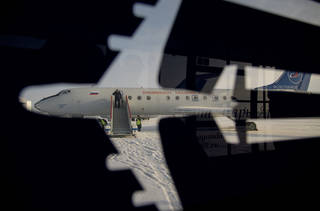
Host: December 17th. The next day is dedicated to make sure everyone else gets there on time. Rowe is busy managing the logistics, monitoring the flight with the rest of the folks coming from Moscow, all the while keeping track of the landing day logistics. Knowing how the crew was doing aboard the International Space Station and looking out for the weather.
[Background music]
Chad Rowe: So then, afterwards, again, like I said, typically the Russian aircraft will arrive, and there’s plenty of NASA personnel that are onboard this aircraft as well, as well as the whole Russian team, and then other various passengers depending on the circumstances, so by that time, we have everyone who is an active participant in landing with boots on the ground in Karaganda.
Host: For the G-III crew, their main job is to make sure the plane is ready to go. No hiccups for when the crew lands. They use this day to make sure everything is in order.
[Background music]
Bill Ehrenstrom: When we’re in Kazakhstan, one thing we don’t want to have happen is when it’s time to take the astronaut home, to find out the airplane is not ready to go home. So, we do check on the airplane. We did have one mission where we had an electrical panel go out that was going to preclude allowing us to go home. And we got a maintenance guy with the panel who flew directly at Kazakhstan, and they got it replaced just in time to bring them home. So, what we do is we go out to the airplane, the first day back, and we start everything up, make sure everything looks good, and we tell the courier he’s off the hook. Then, depending upon whether upon weather, if it’s summer or winter, if it’s winter, I like to go out to the airplane every day, and at least fire up the [Auxiliary Power Unit] APU, get the airplane warmed up, the flight doc likes to go out and make the beds, and we like to get things all set up, but we like to go out there every day, just to check on the airplane.
[Background music]
Host: For me, it’s a good catch-up day. Both for some of the work I know I’m going to miss in the coming week, and to get some extra Z’s and a workout. December 18th, meeting day. This is the day we all gather to make sure everything is going according to plan. And by “we all,” I mean everyone from every space agency. At this point, everyone has arrived. Medical folks get together first to go over some of the major logistics of landing day.
[Background music]
Shannan Moynihan: My name is Shannan Moynihan, and I’m the Deputy Chief Medical Officer at the Johnson Space Center. So, for this particular mission, I served as the Air Doc, as what we called it, onboard the airplane, the G-III. So, the medical briefing is a really important part of what we do. So, we are meeting with our international colleagues. Obviously, it’s run by our Russian colleagues there, and if we have any international partner, USOS Astronauts onboard, their crew surgeons are also there with us. So, it’s also a really nice opportunity for us to all get together. We talk about the crew a little bit, and we make sure that if there were to be any medical conditions of concern, that everybody who is going to be at the scene is aware, who is a medical provider. In addition, we talk about what our treatment plan might be with respect to whether we’re going to use any prophylactic medications to help prevent some of those symptoms that can occur when you come back into 1G. And we–it’s just a great form for communication amongst the medical cadre, to make sure that we work as one team, which is really kind of amazing if you think about it, big picture. We may not see each other for a year, but we come together, and we’ve all, many of us who work together for 15, 18 years, so there is a camaraderie there to start with. And it really is one team taking care of the crew as a whole.
[Background music]
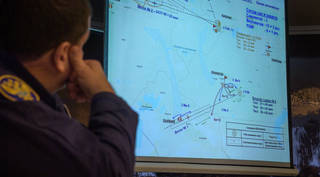
Host: Then, it’s the big briefing. They played this video that shows all of the helicopters and ATVs on this map ready to deploy and where they’re coming from. It’s well-coordinated with vehicles all over the place. Then the video pulls back and shows helicopters and ATVs in different areas from the landing site. It’s something I didn’t appreciate at first, but when you’re going to get people from space who land in the middle of a desert, that desert is kind of like a bullseye, and if something doesn’t go precisely according to plan, they might have to land somewhere else. Most likely another part of the desert. And that could be hundreds of miles away. So, they have to have vehicles and teams ready just in case, staged in a different town. They’re called the ballistic team.
[Background speaking]
Host: Later, a small breakoff team will have a teleconference to make sure everything is set on their end. But during this big briefing, folks from the Russian space agency, Roscosmos, and Russian Search and Recovery Forces get up and present to Alexander Vedernikov, Deputy Director of Rosaviatsiya, and that’s the Russian federal agency for air transport. They each touch on an area that they are responsible for and report readiness. Are the medical supplies ready? Are the helicopters staged? ATVs? Aircraft for the ride home. Are all the personnel here, and ready? Note that all of this is done in Russian, so all of the English speakers are given headsets, so we can hear our interpreter, Evgeny, give simultaneous interpretation of everything that’s being said.
[Background music]
Kenny Todd: Well, I’m listening. It’s always good to get the medical report of what’s going on out in the field, in terms of if there’s any hazardous conditions, things that we need to be aware of. It is everything from frigid cold to, you know, ticks, that you have to watch out for and making sure to take care of yourself. So those are things that when I look at the big picture of how we’re going to conduct business at the landing site, is there anything there that we need to watch out for?
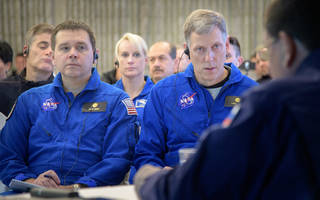
Host: Kenny Todd and Chad Rowe get up to let the Russian teams know that everything is set from the NASA side.
[Background music]
Chad Rowe: The main thing that the Russian leads for the landing deployments want to hear from us is insights about our readiness to tend to the returning crew, so the medical teams have to be fully prepared, and at that point, we usually tell the rest of the audience that the medical teams have had this closed meeting before this meeting, so that the coordination was in place at the next level of detail. They also want to hear that the NASA aircraft is mechanically healthy, ready to complete its mission, and that is more than mechanical. That’s including possible relocations and so on, that could happen under certain contingencies that could happen with landing. And through the help of the Defense Attaché Office at the U.S. embassy in Nur-Sultan, we have preset approval for relocation of the NASA gulfstream, based on various contingencies. So, in most cases, we will be able to move the NASA aircraft without having to go through formal coordination back with the Kazakh authorities.
[Background music]
Host: All of the NASA folks get blue flight suits to represent themselves at this briefing, and more importantly, out in the desert. So, in the excitement after-landing, we can all identify ourselves. It’s not long until the meeting ends, and the mingling begins. But after that wraps up and everyone splits off to grab some lunch, the NASA and European Space Agency folks get together to go over some of the little details. For me, these are big details. One of them includes helo assignments.
[Background music]
Chad Rowe: And the purpose of that briefing is to crystallize the plan, and make sure that there’s been nothing confusing communicated, especially with the real-time interpretation that has to happen during the Russian-led larger meeting. But also, we’re talking about smaller level of details, like who is going to be on which helicopter, both to the landing zone and back, and our communications plan for making sure that we can have tabs on every single non-Russian participant in the landing, as frequently as possible.
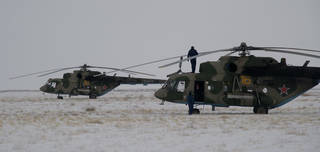
Host: Much of the Recovery Team will be flying out in Mi-8 helicopters. They’re older military aircraft with few, if any, modern instruments. But there are a lot of them deploying to the desert, and a lot of people on those aircraft. It could be pretty tight. So, if you’re assigned to a specific helo to fly out and back, calling helicopters helo for short makes things a bit easier, when you have this helo and the associated number a bunch of times. Probably common in the military, but for me, it’s pretty cool. Sometimes you get the same helo both ways. Sometimes it’s different. And sometimes the helos deploy at different times, even from different airports. That happened to me before. I was one of the first ones to head out to the landing site, but from a different airport. So, it’s critical to pay attention. A lot of times, the public affairs officer will ride back on the media helicopter. This one is designated for photographers usually. Pilots of these helos fly pretty close to the capsule, and land early to make sure that the day is captured in the best way possible. For me, a ride back means I’ll be leaving with these guys, and usually it will be one of the first ones to leave after everything is done. So, it’s an important part of my job not to miss it. This NASA and ESA meeting goes over those little, but important, details. Including who is riding on what helo. Some of us have been assigned to carry satellite phones. I’ll have one to call into NASA TV from the desert. But a lot of other NASA personnel will have them for emergency reasons. Like Kenny Todd, having one to call the International Space Station Management Center, back at the Johnson Space Center, in case anything goes wrong. But we’re also reporting when things go right. Anyone with a satellite phone is the communications lead for their helo. We report when the wheels are up, and the wheels are down, letting everyone know exactly where we are, and where we’re supposed to be, and when. All from the desert. Usually a lot of logistics regarding helicopters and transportation don’t get finalized until around this time, and it’s not consistent every time either. Sometimes we head out early on helos and stage in the town of Dzhezkazgan, or Dzez, as many NASA veterans of these trips will call it, which is much closer to the landing site. Sometimes we’ll go to Dzez a few hours early and just wait for the landing. Sometimes we leave right from Karaganda. This time, we’re taking an AN-26 aircraft a day before the landing to sleep over at a hotel in Dzez. We’ll wake up super early from there, head to the airport, where our helos will be waiting, and right about at the time of de-orbit burn for the crew, which marks between 50 and 60 minutes until landing, we’ll head out on the helos for the 45-minute trip to the landing site and wait. After a long day of meetings and a big dinner, most folks including me go to bed a bit early. Again, I get nervous that I’ll forget something, so I’m 95 percent packed. There’s just one issue. When we deploy to Dzez, we don’t take all of our bags. Knowing that right after landing we all go home, and that the AN-26 won’t be able to hold everybody’s things, we travel to the remote town with nothing but a backpack. That backpack will have stuff for the day before, and the day of, landing in December, where I learned in Pennsylvania that layers are good. I have pretty much everything shoved into this backpack when I remember what’s going to happen to our larger suitcases. Not only will we not be able to bring them with us, but they’ll be stored on the jet, ready for us whenever it’s time to depart. Normally this wouldn’t be much of an issue, but the temperatures will drop well below zero overnight, and they don’t intend to keep the plane running through that whole time. Electronics have a chance of freezing, and I have quite a number of electronics, including a bulky engineering laptop. Guess I’m taking it to the Kazakh Steppes.
[Background music]
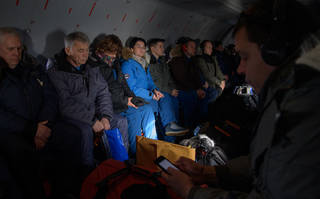
Host: December 19th. From the next day on, through landing, I would sum up this period as “hurry up and wait.” We are up early the next morning to rush off to the airport and wait for the AN-26 aircraft, and the rest of the fleet, to get ready to deploy to Dzez. We’ve all dropped off our bags and are traveling light at this point. Finally, we get through security and take a shuttle over to the aircraft. There are a few folks there to help guide us onto the plane. Normally this would be pretty easy to walk up the ramp, but with the cold and ice, you wouldn’t want to be that guy that slips on his way up. The AN-26 is a military plane, and has benches along the side, and nice open middle for you to throw your bag. Once everyone picks a seat and gets settled, I bring out my earplugs. An absolute must for these trips. These military aircraft, both the AN-26 and the Mi-8 helos are really, really loud. After takeoff, I switch the headphones, and turn on some podcasts to help pass the time. Most folks are leaning back to try to get a quick nap in. Some are chatting, but I honestly don’t know how, because it’s so loud. After landing, we walk or rather slide down the ramp, to another bus to get to our hotel in Dzez. Our interpreter, Evgeny, is helping us to check in, one by one. We’ll have a little downtime before an early dinner, so we all get enough sleep for landing day. Finally, at dinner, I bring out the chips and salsa. I’ve been carrying these everywhere. In fact, I needed to go back into the AN-26 after landing, because I forgot the chips under my seat. But it was all super worth it. Not that the food in Kazakhstan isn’t good. Actually, I feel like it’s pretty darn good. But I personally like pretty much all food. But having that little taste of Houston all the way over in Kazakhstan after a long day of travel was incredible. Still, though, I dive into the Pelmeni for dinner. Somehow, I got a seat next to Kate Rubins at the dinner table, who has been in Russia, in Kazakhstan before, for training, even before–after her own space mission. So, I went with whatever she was having, knowing it would be awesome. Sitting next to astronauts, medical doctors, program representatives, photographers, not bad for a last night in Kazakhstan. We all paid for our stay at the hotel that night, knowing that it will be an early day tomorrow, and we will need to rush out. Another early bed time throws me off a bit. I end up pulling up a movie I’ve saved on my laptop to help pass the time. I pull up some of the statistics and refresh myself on the timeline tomorrow, knowing that I’ll have to be on air.
[Background music]
Host: December 20th, landing day. After breakfast, we all get changed into our flight suits. Growing up in Pennsylvania and knowing there will be over a foot of snow in the desert, I bring snow pants, that I usually use for skiing. Apparently, nobody does this. So, I’m the butt of a few jokes right off the bat. But I don’t take being out in the Kazakh desert lightly. It’s blistering cold, below zero Fahrenheit in the morning, and the landing site is looking to be about 15 below. I have gloves, boots, a hat, a mask, and about five layers of insulation. But being landing day, it’s not long before everyone is distracted with their duties. Some folks are working logistics. Others are preparing medical equipment. I’m assigned to the helo with all the photographers, so they’re getting all of their equipment ready. We hurry up and wait at the airport. Everything seems to be on track for landing. It’s our job to make sure we’re ready to take off at de-orbit burn. As soon as that burn takes place, landing is like clockwork. Basically, counting down from just under an hour to the time of touchdown. And all of that logistics work to get us staged in Dzez was partly around that, which by helicopter is about 45 minutes from the landing site out to the middle of the desert. The weather is all right, but cloudy, making it a bit harder to spot the capsule coming down and making the operations a bit more difficult. The Mi-8 helos are not new, so they don’t have any fancy instruments, and are relying a lot on analog guidance, and line of sight, to find the capsule.
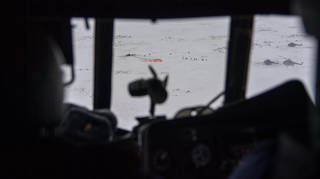
[Helicopter rotor sound in background]
Host: Being on the media helo, we are the first ones to roll out. I have a satellite phone in my hands, and my government cell with an international plan that will help this all go smoothly. It’s my job to report back to Joe Acaba, who is the Lead for Logistics based at the Dzez airport during the operation, and the Space Station Management Center back in Houston. I sent the text that we lifted off, which we did, but then we landed immediately. Apparently, that was a test. Bill Ingalls, the NASA photographer, and a veteran of these trips corrects me and sends the right takeoff time to the Logistics Lead. Good to have a vet onboard. Bill knows exactly what to do on this trip. He works with the other Russian photographers, so everyone gets a good position for taking photos. But it takes about 40 minutes to get to this point. For the most part, we’ve picked spots around the helo to hang out. I’ve shoved some ear plugs in to drown out the intense noise coming from the rotors, but like clockwork, the photographers get set up and try to take some photos. No capsule. They’re working with the pilots to check where it is. Nothing in sight. Weather reports have shown heavy cloud coverage through the Kazakh Steppes. The landing time passes, and we still haven’t seen the capsule. We haven’t gotten any reports of anything going wrong either. Everyone is starting to catch on to what that means. Not too much later, the pilots get a call that the ATVs have spotted the capsule, landed safely and upright. Awesome. And the best news for everyone. But at the same time, dang. No photos of the capsule coming down. Still, we are one of the first helos to land. [Background Music] Our pilot brings us fairly close to the capsule. A short walk, but far enough away so as not to affect the operations going on. Turns out we are one of the first helos to get there. Some teams are preparing structures to retrieve the crew inside. It’s my job to report all of that, I call onto NASA TV which has been broadcasting the crew’s departure and landing live, and report what I’m seeing.
[NASA TV Report]:Well Rob, it is a very brisk winter out here, there is a bit of overcast out here at the landing site, so we weren’t able to see the capsule come down, but here I am right in front of it, capsule erected perfectly —
[Background music]
Host: Sometimes, there is a Russian video crew out at the site, but they haven’t made it there yet. So, my reports of the capsule status, safe and upright, are the first to most. Eventually, a crowd surrounds the capsule. Logistics professionals, medical doctors, program leads, all eagerly awaiting to see the crew who have been living in space for six months.
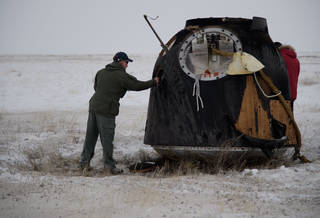
[Background music]
Shannan Moynihan: And so, the search and rescue folks will go and they’re saving the capsule, making sure everything looks good. We’re there at that point in time. So, we’re watching what is going on. I’ve been able to go over and kind of look through the window, get an eyeball on my crew, make sure that they look like they’re doing well, get the thumbs up.
[Background music]
Host: A metallic ladder structure is erected around the capsule, and two guys climb up to open the hatch, and then begin reaching down to extract the crew one by one. By this time, the Russian videographers have shown up and will get good footage of the crew coming out.
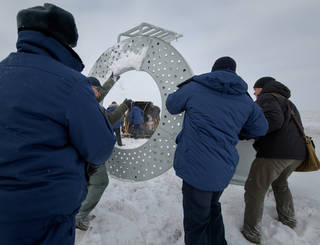
Kenny Todd: Well, as a person who works very closely with the day-to-day operations, I’m always amazed when we get off the helicopters, and we run up to the capsule, and you can still smell that, they call the Soyuz smell, the kind of burning electrical smell that you can always see after a vehicle just enters back into the atmosphere. It’s pretty amazing. And then when they open up the hatch, and you think, I was just literally talking to that person a few days ago in a crew conference call, or else you know, just seeing them on my TV in my office, floating around, and now here they are, down on the ground, and yeah, it’s–you know, there’s a swarm of people that are usually trying to look inside the capsule, you know, looking for those thumbs up, and it’s always good to see three thumbs up from the crew, so, anyway, it’s a pretty surreal type of, you know, happening, and it really, like I said, becomes very, very real when you see some smiling faces inside the capsule. It’s very cool.
[Background speaking]
Host: First is Sergei Prokopyev, Soyuz Commander, and first-time flier. Alexander Gerst comes next, European Space Agency Astronaut, and a Space Station Commander for Expedition 57. NASA Astronaut, Serena Aunon-Chancellor comes out last. Three chairs have been aligned right in front of the capsule, and both the chairs and the capsule have been sanctioned off, so media or others don’t get too close while the doctors are tending to them. An orange medical tent was constructed way off in the distance, probably about 200 yards away. The doctors, Raxana Bastmanova for Serena, hands satellite phones to the crew with their family on the other line, so they can hear straight from the crew that they’ve made it back safely to Earth. But with all the crew members seated in front of the cameras and looking healthy, I sign off. In the winter, the field reporter doesn’t stay on air for too long, so we don’t have to deal with our gloves off, and the phone in our ear, with the blistering cold.
[Background music]
Shannan Moynihan: They go, and they’ll put them into a seat, so they can kind of stabilize for a little bit. A lot of that is to try to help with that adaptation back to 1G. So just sitting quietly and still helps with this, the symptoms that can sometimes occur.
[Background audio sounds]
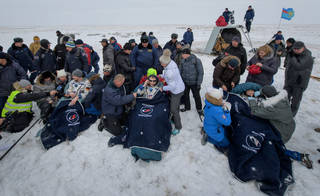
Host: After a bit, the crew will be carried to the medical tent for some exams. For a while, they were conducting something called field tests in these tents. Beyond the normal checkup, the crew members were to conduct a series of tasks like sitting up and down, walking back and forth, and some other test, to see how they were immediately adjusting back to 1G. This time, they would only do a few medical exams, except for Sergei Prokopyev, who would continue with some field tests.
[Background music]
Shannan Moynihan: You know, so we work to make sure that they’re feeling well, and if they’re not, we take interventions as needed to get them feeling well and make sure that the travel back, that they’re stable for the travel, and just making sure that we’re getting them to feel as well as they can for that whole process.
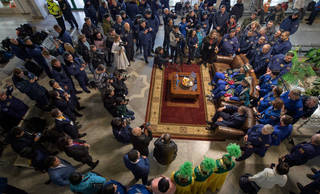
Host: After they got carried into the tent, my job was done. I didn’t have the right equipment to enter the tent, and I already had reported the status of the crew. So, I recorded a few sounds for this podcast, took some photos, and then waited by the helo. Traditionally, the photographers have a lot of work up front too. So, the media helicopter is the first to take off. And it’s not super apparent when they’re going to be doing that. [Background Speaking] Back at the Dzez airport, things are already getting staged for a ceremony. When the crew arrives, they’ll be dressed in ceremonial Russian caps and hats, and they’ll be given matryoshka dolls, that have been decorated with their image. I meet Dr. Keith Brandt and Rimma Sadretdinova, who were in helos over another part of the desert, on the ballistic site. This is an alternative landing zone, where if the crew needed to, they could reenter the Earth’s atmosphere faster, and at a steeper incline. It would be rougher, but the option is there if they needed it. And there were those helos flying around, with medical doctors aboard, just in case. Prokopyev and Gerst arrive to take part in the ceremony, but on Aunon-Chancellor had opted out of the ceremony, not feeling up to the task. This is why it’s critical to continue studying the human body during and after spaceflight. Think about Mars. After a six to nine-month journey, astronauts will have to go through similar stresses of adjusting to Mars gravity, and they won’t have the convenience of being carried into a medical tent with doctors waiting to treat them and care for them as they adjust over the next several hours.
[Background music]
Shannan Moynihan: You know, Mars is a completely different ballgame. They’re not going to have a group there to pick them up when they land, and who are going to help support them for the first 24 to 48 hours, the way we do currently. You know, they’re not going to a 1G environment, but still, we’re not really sure what the effect of that partial G environment is going to be like on their bodies, so will they have a lot of the same symptoms that we see when they come, you know, back to 1G here on Earth? It’s a question, you know? And to not have somebody there necessarily within the crew who can put IVs in and help support them, and until they get, you know, past that adaptation period is going to be interesting. So, what we’d like to do is try to understand the mechanisms, and come up with ways to mitigate, and counter-measure, so that maybe when they get there, they won’t have those effects anymore.
Host: I did get a chance on my most recent landing trip to get a few short comments from Nick Hague, who was more than happy to share his experience, despite not being able to sit upright. Here is what he had to say, just a few hours after landing from space in October of 2019.
Host: Nick Hague, welcome back to Earth! I’ll start off by saying this, how are you feeling?
[Background speaking/music]
Nick Hague: I am, it’s–so nice to be back. You know, and thanks for the welcome, Gary. It’s–it’s a little bit of mixed emotions, because I left behind some really good friends, and seeing them, you know, it’s going to be fun to watch them go to work up there but going to miss being with them. But that is definitely outweighed by the tugging to get home, the tugging in the heart to get home to Katie and the boys, and just be with them, and reflect on everything that’s transpired over the last year. Because it has been a–quite a year. There has been several ups and downs.
[Background speaking/Music]
Host: Can you tell me about your expedition, then, what you’re reflecting on now, as you’re sitting here?
Nick Hague: You know, when I look at the entire year in review, you know, from the first launch, and then following up with the second launch, and in the big question that is, in your mind, is, “OK so I’m back now. Was it worth it?” And so, you start to take stock in, you know, what did we accomplish up there? You know, we did several spacewalks, and proved the station capabilities and extended its life, which is definitely a huge thing. All the different science experiments that we were able to support up there. Whether it’s trying to look, you know, at new materials, or new drugs, or just understand biology better, so that we can figure out how to come up with cures to, you know, significant diseases, being able to be part of all of that is something that I never imagined I would be able to be part of, and you know, so the answer for me is that it is all worth it. And now, you know, now I’m back, and I look forward to continuing to be able to support our mission, you know, in a different role, but it’s a gigantic team across the entire globe, and it has been a privilege to be a part of it.
[Background music]
Host: Back in December 2018, for the expedition 57 landing, the head of Roscosmos, Dmitry Rogozin, is there to provide comments as well as present gifts to the crew. There are a lot of others from Roscosmos, Energia, NASA, and the European Space Agency, as well. Lots of media. Locals bearing gifts, and of course, the teams from the landing site returning to witness the ceremony. One of the best parts of this whole experience is witnessing people from all over the world. In this one spot, appreciating this moment in history. It’s not long until the astronauts are escorted onto their planes for the ride home.
Bill Ehrenstrom: So, the astronaut lands, about five hours later, they end up on the airplane and ready to go. That’s what we typically plan. It’s about five hours. From the actual touchdown of the capsule until they’re back on the airplane.
[Background music]
Shannan Moynihan: So, onboard the G-III, which is what we were flying on, we have medications to help with immediate post-landing effects, that the crew members might be going through. Really basic things, like IV insertion and IV fluids, and some normal saline, to help with the–any blood pressure issues that we might be seeing, orthostatic hypotension, another fancy term. Sometimes their blood pressure gets a little low, so we can help make them feel better by getting that raised a little bit for them. In addition, we do carry capability, in case we have a bad day. So, our operational concept, we are really trying to make sure that we don’t bring anyone onto the NASA plane who is seriously injured. All of those people would be cared for locally. We have a plan in place for how that would happen. So, the flights home average about 18 hours, sort of door to door, for the most part, depending on how long you stay at some of the stopovers. And we do try to make it a comfortable ride home for the crew as well. Often, they’re pretty tired. So, we have wonderful mattresses and beds made for them. That’s actually part of what I do to get the cabin ready before they come onboard. So, I’m a double board-certified surgeon in emergency medicine, in aerospace medicine, and I make the beds for the crew, to make sure that they’re comfortable coming home. We have fluffy, warm blankets. As you know, it can get a little bit chilly when you’re in the airplane. We have some of their favorite foods and drinks that their families have often provided, so they get a little taste of home even before we get there. My job is I want to make sure they’re getting enough rest. I want to make sure they’re getting hydrated. I also participate and help collect what we call BDC, which is some of the science that’s being done. So sometimes we collect we’ll say bodily fluids [laughs] for testing, and we do that through the–you know, a lot of science investigators want that first 24 hours of data, right? That’s when a lot of the changes occur physiologically. Well, 18 to 24 hours of that time they are on a plane or traveling. So, we try to do as much of the science as we can onboard the plane as well.
[Background music]
Host: Aunon-Chancellor and Gerst will take the G-III over to Norway, where another jet will be waiting to take Gerst to Cologne, Germany. As Aunon-Chancellor continues back to Houston for the quick direct return. Flight docs will tend to them along the way. And researchers will be waiting in both locations to continue studying the effects of the human body in the weeks following landing. For me, I’ll ride back with Prokopyev back to Star City, Russia, along with a few dozen other folks from Roscosmos, NASA, and the European Space Agency. The trip isn’t that long, and I try to catch some Z’s on the way over. From Star City, I’ll take a short bus ride, then a van ride over to Moscow, and there, I’ll have about five hours to repack and nap until I get up again and head to the airport for the trip back to Houston commercially. It’s a long and exhausting trip, but thanks to months of organization, international collaboration and decades of human spaceflight experience, the complicated operation of a Soyuz landing goes seamlessly.
[Background music]
Kenny Todd: It’s an International Space Station, and when you get in that area in Kazakhstan, it’s such a microcosm of that partnership right there in one hotel. We’re all staying together, we’re all eating together, we’re passing each other and saying hello, and sometimes we’re eating meals together. It really, you know, it just amplifies even more what an international partnership we’re on. There’s no telling when you walk from couch to couch in the lobby what language you’re going to hear. And yet at some point, we’re all going to get on helicopters, and we’re all going to head out into the field, and again, we effectively operate as one team out there, recovering, whether it’s European astronauts, or NASA astronauts, or Russian cosmonauts. You know, everybody is acting as one, and again, it’s a wonderful partnership, and you really get to see it play out when you’re out in the field like that.
[Background music]
Host: We talk a lot about the work that goes into making human spaceflight a possibility. But when you see it up close, and understand the complexity of it all, you really appreciate it. It’s done thoroughly, efficiently, and with the intent of learning how to travel further, to the Moon, and to Mars. These practices and technologies can be brought down to Earth, to benefit our own lives, and to inspire future generations to continue the quest to reach new heights and reveal the unknown. And I’m glad to be a small part of it.
[ Music ]
Host: Hey, thanks for listening to this episode. I hope you liked it. It’s a little different from what we normally do. If you like this podcast, we have 139 others. Go to NASA.gov/podcasts to check out more episodes of Houston, We Have a Podcast and the many other podcasts across the entire NASA agency. If you want to know more about the International Space Station, go to NASA.gov/iss. You can follow us on social media. We’re on Facebook, Twitter, and Instagram. We’re at the NASA Johnson Space Center pages of all of those. Use the hashtag #AskNASA on your favorite platform to submit an idea for the show. Make sure to mention it’s for Houston, We Have a Podcast. I’d like to thank Kevin on Twitter for submitting an idea to do an episode on a Soyuz landing. Sounds for this podcast were recorded during the landing trip of December 2018. Interviews were recorded in March of 2020. Thanks to Alex Perryman, Norah Moran, Belinda Pulido, Jennifer Hernandez, Dan Huot, and Pat Ryan, for helping to pull it all together. We’ll be back with another new episode next week.





























